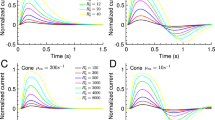Abstract
A conditioning light can cause a decrease (adaptation) or an increase (facilitation) in the sensitivity of barnacle photoreceptors, as measured by the amplitude of the late receptor potential (LRP). We show that a net transfer of visual pigment from the rhodopsin (R) to the metarhodopsin (M) state induces a large facilitation whereas the reverse transfer results in a much smaller facilitation or even an adaptation. These effects were not due to the response to the conditioning light but to the pigment reactions. When the conditioning light did not alter the pigment population (i.e., M → M, R → R) it was followed by an intermediate degree of facilitation. These conclusions are correct for cells which have relatively low sensitivity. In sensitive cells, all pigment transitions produce adaptation.
LRP facilitation and the prolonged depolarizing afterpotential (PDA) show several common characteristics with respect to pigment transitions: 1.Their magnitude increases with the amount of pigment transferred from R to M. 2. Both are depressed by the M → R transition. 3. Their production is impeded by the M → R transition. 4. The PDA itself is facilitated by the R → M transition and this facilitation decays with a time course comparable to that of LRP facilitation. These results suggest that there may be an underlying process common to LRP facilitation and PDA.
Similar content being viewed by others
References
Atzmon Z (1980) Some observations on facilitation in barnacle photoreceptors. Isr J Med Sci 16: 619
Atzmon Z, Hillman P, Hochstein S (1978) Visual response in barnacle photoreceptors is not initiated by transitions to and from metarhodopsin. Nature 274: 74–76
Bolsover SR (1980) Sensitization in voltage clamped barnacle photoreceptors. J Physiol (Lond) 306: 65–78
Hanani M, Hillman P (1976) Adaptation and facilitation in the barnacle photoreceptor. J Gen Physiol 67: 235–249
Hanani M, Hillman P (1979) Absorption of light by metarhodopsin modifies the effect of a conditioning light on the barnacle photoreceptor. Biophys Struct Mech 5: 231–235
Hillman P, Hochstein S, Minke B (1976) Non-local interactions in the photoreceptor transduction process. J Gen Physiol 68: 227–245
Hochstein S, Minke B, Hillman P (1973) Antagonistic components of the late receptor potential arising from different stages of the pigment process. J Gen Physiol 62: 105–128
Lisman JE, Strong J (1979) The initiation of excitation and light adaptation in Limulus ventral photoreceptors. J Gen Physiol 73: 219–243
Minke B, Hochstein S, Hillman P (1973) Early receptor potential evidence for the existence of two thermally stable states in the barnacle visual system. J Gen Physiol 62: 87–104
Razmjoo S, Hamdorf K (1979) Visual sensitivity and the variation of total photopigment content in blowfly photoreceptor membrane. J Comp Physiol 105: 279–26
Strong J, Lisman JE (1978) Initiation of light-adaptation in barnacle photoreceptors. Science 200: 1485–1487
Author information
Authors and Affiliations
Rights and permissions
About this article
Cite this article
Hanani, M., Hillman, P. The contribution of pigment transitions to sensitivity changes in the barnacle photoreceptor and the correlation with the prolonged depolarizing afterpotential. Biophys. Struct. Mechanism 8, 161–172 (1982). https://doi.org/10.1007/BF00535457
Received:
Accepted:
Issue Date:
DOI: https://doi.org/10.1007/BF00535457




